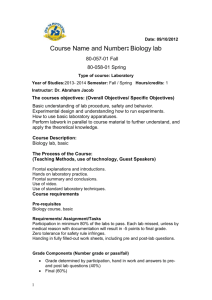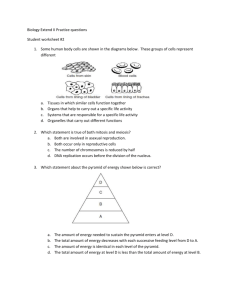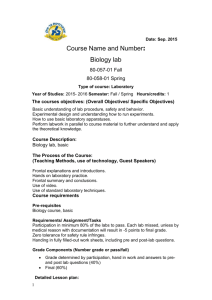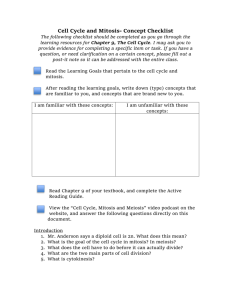Natural Selection Video Guide
advertisement
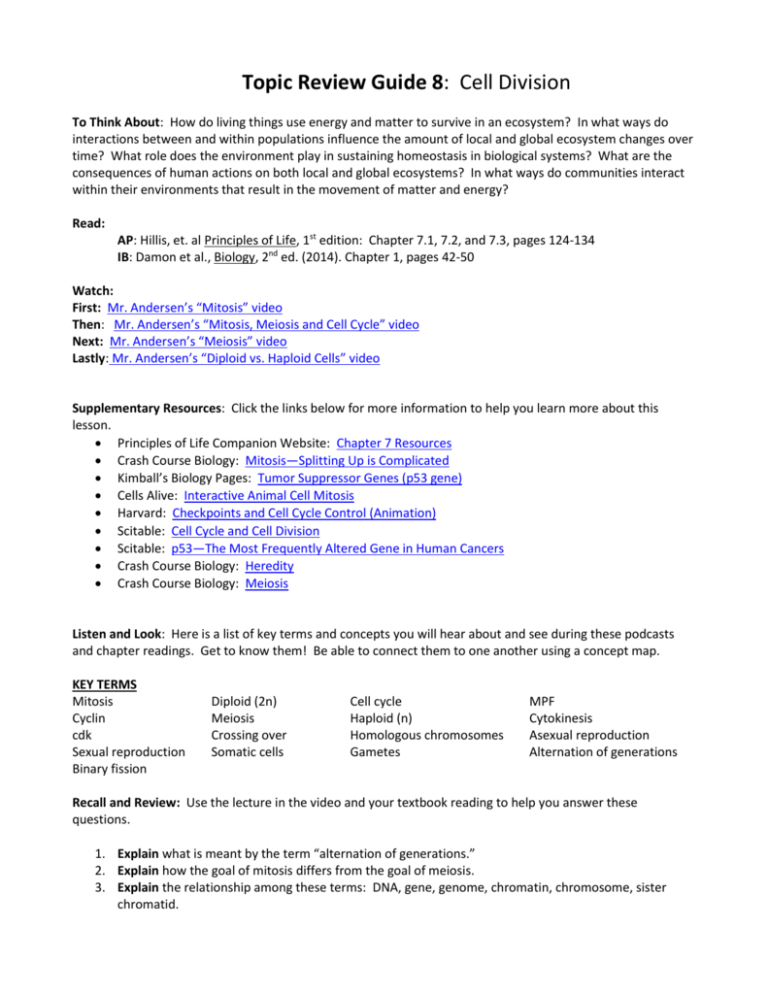
Topic Review Guide 8: Cell Division To Think About: How do living things use energy and matter to survive in an ecosystem? In what ways do interactions between and within populations influence the amount of local and global ecosystem changes over time? What role does the environment play in sustaining homeostasis in biological systems? What are the consequences of human actions on both local and global ecosystems? In what ways do communities interact within their environments that result in the movement of matter and energy? Read: AP: Hillis, et. al Principles of Life, 1st edition: Chapter 7.1, 7.2, and 7.3, pages 124-134 IB: Damon et al., Biology, 2nd ed. (2014). Chapter 1, pages 42-50 Watch: First: Mr. Andersen’s “Mitosis” video Then: Mr. Andersen’s “Mitosis, Meiosis and Cell Cycle” video Next: Mr. Andersen’s “Meiosis” video Lastly: Mr. Andersen’s “Diploid vs. Haploid Cells” video Supplementary Resources: Click the links below for more information to help you learn more about this lesson. Principles of Life Companion Website: Chapter 7 Resources Crash Course Biology: Mitosis—Splitting Up is Complicated Kimball’s Biology Pages: Tumor Suppressor Genes (p53 gene) Cells Alive: Interactive Animal Cell Mitosis Harvard: Checkpoints and Cell Cycle Control (Animation) Scitable: Cell Cycle and Cell Division Scitable: p53—The Most Frequently Altered Gene in Human Cancers Crash Course Biology: Heredity Crash Course Biology: Meiosis Listen and Look: Here is a list of key terms and concepts you will hear about and see during these podcasts and chapter readings. Get to know them! Be able to connect them to one another using a concept map. KEY TERMS Mitosis Cyclin cdk Sexual reproduction Binary fission Diploid (2n) Meiosis Crossing over Somatic cells Cell cycle Haploid (n) Homologous chromosomes Gametes MPF Cytokinesis Asexual reproduction Alternation of generations Recall and Review: Use the lecture in the video and your textbook reading to help you answer these questions. 1. Explain what is meant by the term “alternation of generations.” 2. Explain how the goal of mitosis differs from the goal of meiosis. 3. Explain the relationship among these terms: DNA, gene, genome, chromatin, chromosome, sister chromatid. 4. Create a Venn Diagram to compare and contrast the processes of sexual and asexual reproduction. 5. Create a t-chart that outlines the similarities and differences between binary fission and mitosis. Explain why binary fission cannot be considered mitotic division. 6. Discuss the advantages and disadvantages of sexual vs. asexual reproduction. Explain why each type of reproduction is important to the evolution of multicellular organisms. 7. The term “mitosis” is Greek in origin and means “division of the nucleus.” Explain how the steps of this process fit the definition of the word. 8. Explain how cytokinesis differs in plant and animal cells. 9. The cell cycle is controlled by a multitude of factors. Explain the role of each of the following in ensuring that cells divide appropriately. a. G1, G2 and M checkpoints b. CDK’s and Cyclins c. MPF (mitosis-promoting factor) d. p53 gene (use this site: http://users.rcn.com/jkimball.ma.ultranet/BiologyPages/C/CellCycle.html to find information on p53) 10. Certain chemotherapeutic agents used to treat cancer such as vincristine act on the formation of microtubules. Explain what would happen to a dividing cell treated with vincristine during metaphase. 11. Explain the relationship among these words: gene, DNA, chromosome, chromatid. 12. Explain why meiosis is often called “reduction division.” 13. Explain how each of the following contribute to genetic variety among members of the same species: a. Crossing over b. Independent assortment c. Random fertilization 14. Create a graphic organizer that illustrates the differences between meiosis and mitosis. 15. Describe three genetic disorders that can result from nondisjunction during meiosis. Learn More: For more information about cell division and its regulators look at the links below. Nobelprize.org: Control of the Cell Cycle Game Nobelprize.org: 2001 Nobel Prize in Physiology/Medicine awarded to Leland Hartwell, Tim Hunt and Sir Paul Nurse “for their discoveries of key regulators of the cell cycle.” The Biology Project: Onion Root Tips—Determining Time Spent in Different Phases of the Cell Cycle Rebecca Skloot: The Immortal Life of Henrietta Lacks (about the woman from whom HeLa cells are derived)



